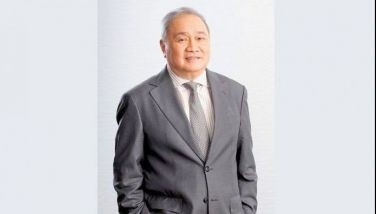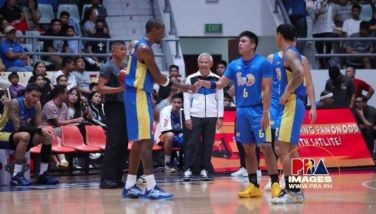Reporter’s notes on the EDSA Revolt

February 1986 was about to end and rumors of an impending coup, massive government revamp and other mayhem were rife.
(This article was contributed by Nonnie Pelayo, the defense/military reporter of the then Philippines Daily Express in 1986 who covered the EDSA Revolt of Feb. 23-25 from start to finish.)
On Feb. 21, PC chief Lt. Gen. Fidel V. Ramos told reporters in an ambush interview at the Philippine Constabulary headquarters in Camp Crame: “I am asking Malacañang to stop this talk about revamps and other movements in the government. I am trying to maintain a semblance of stability in a very unstable situation.”
That made the headlines of the next day’s newspapers.
In the afternoon of Feb. 22, I was at the PC Public Information Office when a colleague called me: “Magpunta ka dito (Camp Aguinaldo) may mga sniper sa bubong ng MND (Ministry of National Defense). Naka-black bonnets.”
Entering Aguinaldo was not a problem. Security was not heightened and everything was “normal.” At the reporters’ lounge of the MND Public Affairs Office, the “usual suspects” were in full force, plus some others.
As I was entering the building, helicopters landed on the front lawn. Heavy big black bags that presumably contained weapons were unloaded.
Reporters were told that Defense Minister Juan Ponce Enrile would hold a press conference at 4 p.m. The time was later moved to 5 p.m., making newsmen ask where Enrile was.
One wag answered, “Tinatanggalan pa ng posas.” There were rumors that Enrile would be arrested.
Finally, at 6 p.m., the reporters were told to go to the MND social hall. Enrile was already there waiting, without handcuffs, of course.
Just as Enrile started to speak, Ramos, the bête noire of Gen. Fabian Ver, AFP chief of staff, and other high military officers entered.
Enrile announced that he and Ramos were withdrawing their support from the government. He explained why.
Several minutes into the presscon, Brig. Gen. Ramon J. Farolan, who was then seconded to the Bureau of Customs as its commissioner, arrived. Moments later, retired Gen. Romeo Espino entered and sat with Enrile and Ramos at the table.
After the presscon, Ramos stood to go back to Crame. Before he boarded his car he told me and another reporter, “Follow me.” So there we went to Crame – and, as they say, the rest was history.
While Enrile and Ramos were announcing their breakaway, top leaders of Malacañang and the Armed Forces were at the St. Therese Cathedral at Villamor Air Base for the wedding of the son of Air Force chief Maj. Gen. Vicente Piccio, a Ver loyalist and one of the “stooges.”
Ramos then started calling PC provincial commanders, asking for their support and giving them instructions.
That night, Ramos announced on radio the names of the generals and other senior officers who had pledged support to his cause. That stymied Ver, who had to double-check his officers’ loyalty. Their commander, Capt. Rosendo Ferrer, must have had a bad migraine together with his boss, Maj. Avelino I. Razon Jr., the commander of Ramos’ security detail.
Aside from radio reporters, among the early callers of Ramos on the first night were Joker Arroyo and Butz Aquino and the September 21 Movement.
On the Catholic Church-run Radio Veritas, a voice came on air: “This is Cardinal Sin speaking… I am calling our people to support our two good friends at the camps.”
In the wee hours of the next day, the portion of Epifanio de los Santos Avenue between the two camps was already crowded as many heeded Sin’s call for “People Power.”
Ramos came out of Crame and went to Edsa to address the crowd, thanked them, and updated them on what was going on.
Later that day, nuns, priests and seminarians joined the throng at EDSA and nearby streets. It was the religious who stopped the tanks sent to crush the rebellion.
At Crame, a former reporter who had become a priest came to join his friend Eddie (Ramos). The priest, Fr. Bert Clemena, later gave a general absolution to all of us at the Camp Crame chapel.
Col. Antonio Sotelo and his helicopters later arrived at Crame. That turned the tide and one camp after another was surrendered to the rebel forces.
While the helicopters were approaching, the battle-scarred warriors on the ground did not raise their guns to challenge the aircraft. They were ordered to put down their weapons.
That afternoon, Brig. Gen. Pedro Balbanero, commander of the Military Police Brigade and most senior officer present at Camp Aguinaldo, surrendered the camp to the rebels.
The Marines were sent to attack Crame but they did not fire. Col. Braulio Balbas, who was then the commander of the Combat Support Brigade of the Marines, was sent with two artillery batteries to Aguinaldo with orders to attack Crame across Edsa, but he did not fire the howitzers.
He told us later: “Bore-sighted na ang HPC, no need for a map. But I did not have the heart to fire. Parang nakikita ko ang asawa at mga anak ko sa People Power.”
At Fort Bonifacio, the Army headquarters, howitzers were also trained on Crame but no order to fire was issued. It turned out that the magnetic maps needed to aim those guns were of World War II vintage. So if they were fired, the shots would have gone all over Cubao and Greenhills but not Crame.
While all this was happening, prayers stormed the heavens. Countless rosaries were recited and masses offered.
Indeed the event of Feb. 22 to 25, 1986 that ended with minimal bloodshed was a miracle.
* * *
NB: All Postscripts are also archived at ManilaMail.com. Author is on Twitter as @FDPascual. Email: [email protected]
- Latest
- Trending




























